Accounting Issues: IFRS 15, IFRS 16, and Expected Credit Loss Review
VerifiedAdded on 2020/12/30
|13
|3885
|416
Report
AI Summary
This report provides a comprehensive review of current accounting issues, focusing on the application of IFRS 15 (Revenue from Contracts with Customers) and IFRS 16 (Leases), along with an analysis of the exposure draft on expected credit loss. The report examines the five-step process for revenue recognition under IFRS 15, including identifying performance obligations and allocating transaction prices. It also explores the implications of IFRS 16 on lease accounting and potential errors in the implementation of IAS 16 (Property, Plant & Equipment). Furthermore, the report analyzes the issues covered in the exposure draft on expected credit loss, highlighting the perspectives of key respondents such as Deloitte, CFA Institute, FinREC, and the Investor Advisory Committee. The analysis covers the expected credit loss model, the importance of time value and discount rates, and the essential disclosures required for transparency. This report is valuable for students and professionals seeking a deeper understanding of current accounting challenges and standards.
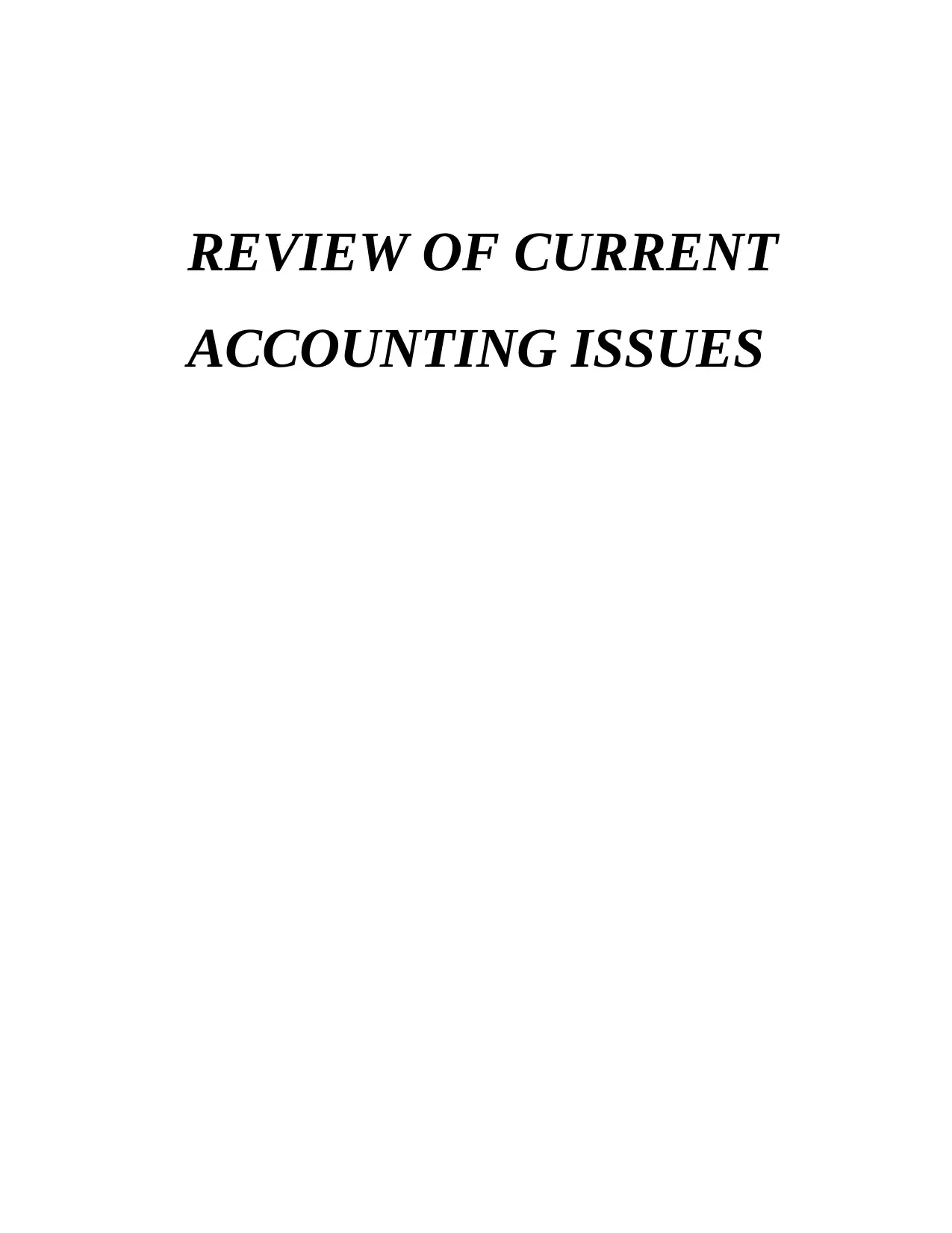
REVIEW OF CURRENT
ACCOUNTING ISSUES
ACCOUNTING ISSUES
Paraphrase This Document
Need a fresh take? Get an instant paraphrase of this document with our AI Paraphraser
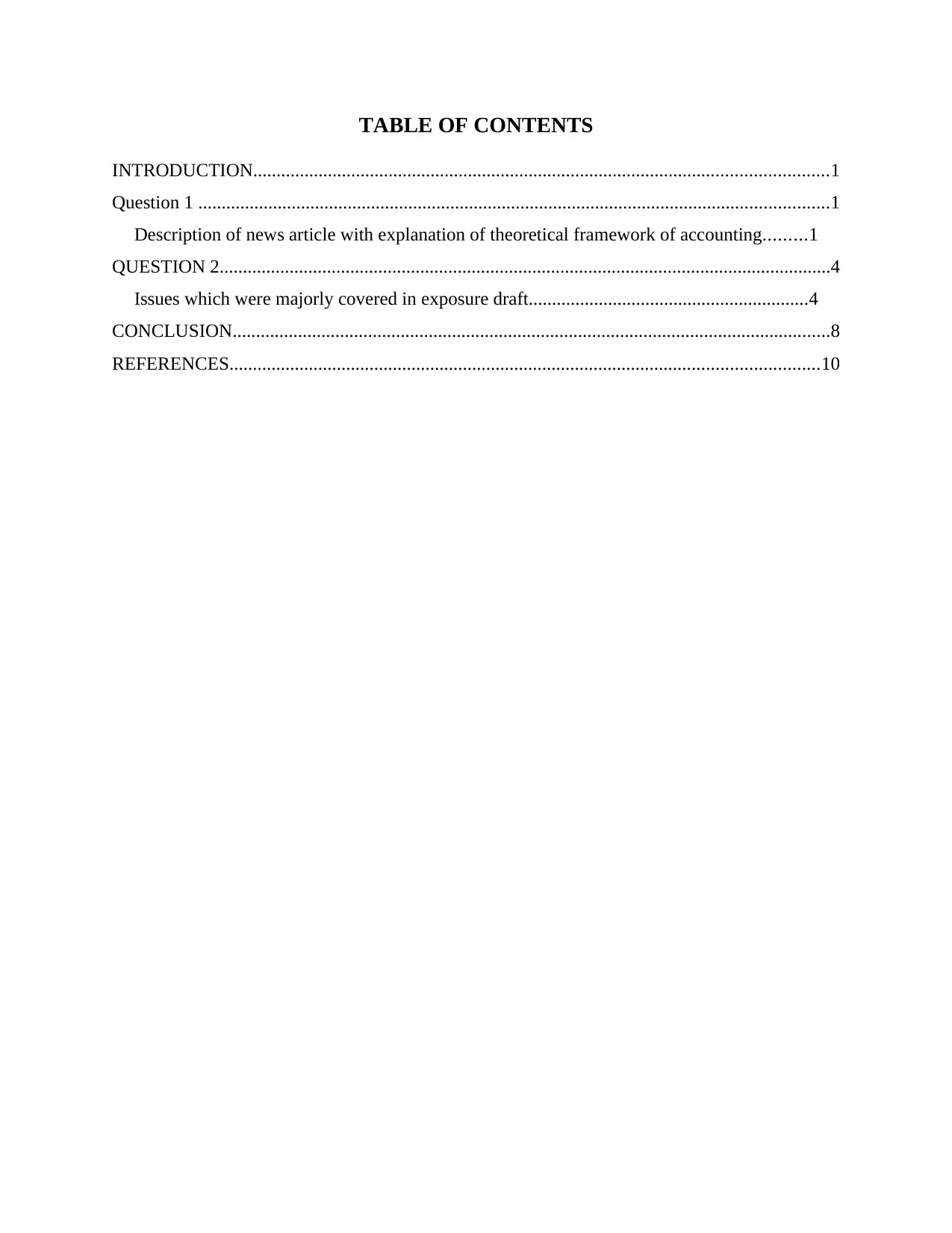
TABLE OF CONTENTS
INTRODUCTION...........................................................................................................................1
Question 1 .......................................................................................................................................1
Description of news article with explanation of theoretical framework of accounting.........1
QUESTION 2...................................................................................................................................4
Issues which were majorly covered in exposure draft............................................................4
CONCLUSION................................................................................................................................8
REFERENCES..............................................................................................................................10
INTRODUCTION...........................................................................................................................1
Question 1 .......................................................................................................................................1
Description of news article with explanation of theoretical framework of accounting.........1
QUESTION 2...................................................................................................................................4
Issues which were majorly covered in exposure draft............................................................4
CONCLUSION................................................................................................................................8
REFERENCES..............................................................................................................................10
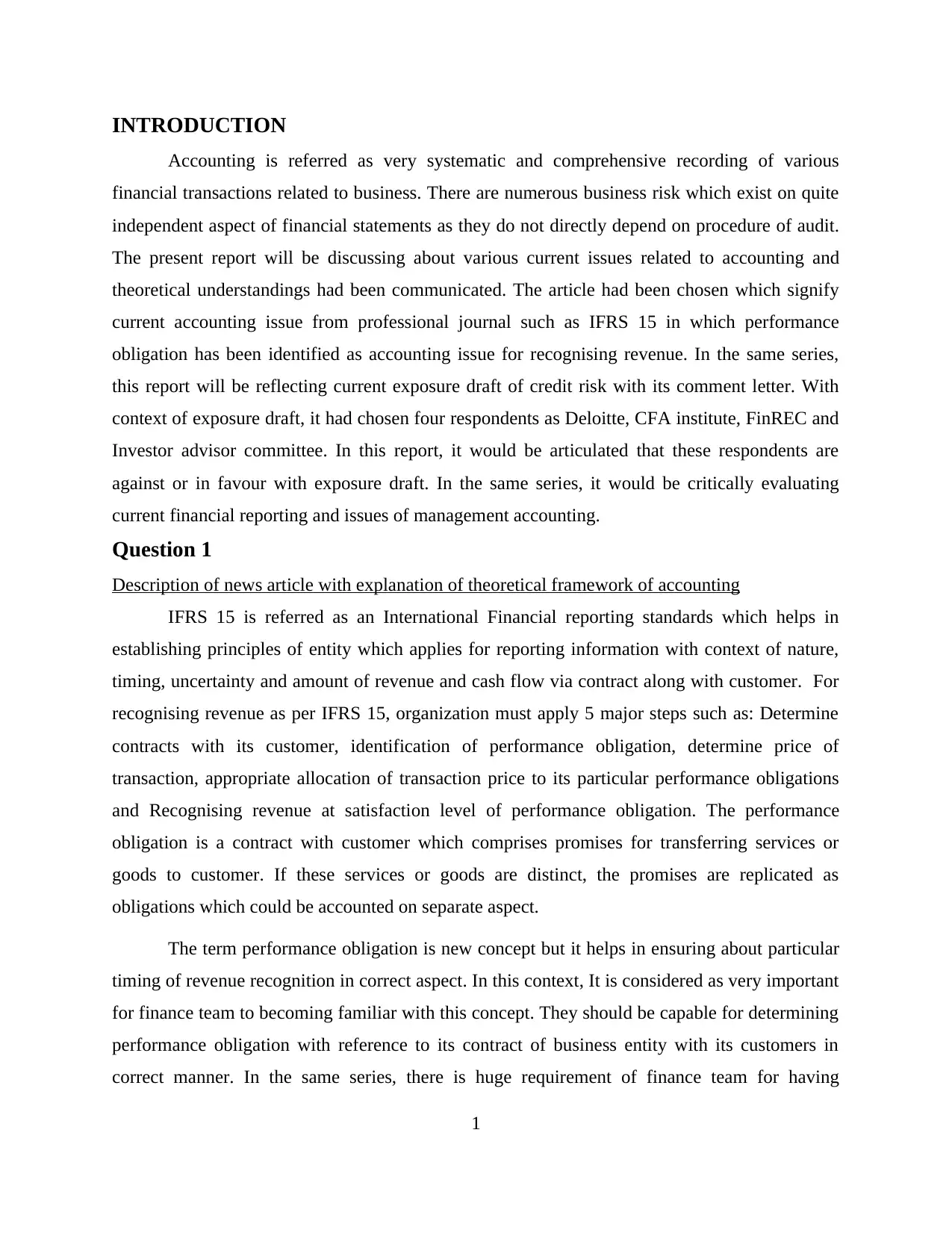
INTRODUCTION
Accounting is referred as very systematic and comprehensive recording of various
financial transactions related to business. There are numerous business risk which exist on quite
independent aspect of financial statements as they do not directly depend on procedure of audit.
The present report will be discussing about various current issues related to accounting and
theoretical understandings had been communicated. The article had been chosen which signify
current accounting issue from professional journal such as IFRS 15 in which performance
obligation has been identified as accounting issue for recognising revenue. In the same series,
this report will be reflecting current exposure draft of credit risk with its comment letter. With
context of exposure draft, it had chosen four respondents as Deloitte, CFA institute, FinREC and
Investor advisor committee. In this report, it would be articulated that these respondents are
against or in favour with exposure draft. In the same series, it would be critically evaluating
current financial reporting and issues of management accounting.
Question 1
Description of news article with explanation of theoretical framework of accounting
IFRS 15 is referred as an International Financial reporting standards which helps in
establishing principles of entity which applies for reporting information with context of nature,
timing, uncertainty and amount of revenue and cash flow via contract along with customer. For
recognising revenue as per IFRS 15, organization must apply 5 major steps such as: Determine
contracts with its customer, identification of performance obligation, determine price of
transaction, appropriate allocation of transaction price to its particular performance obligations
and Recognising revenue at satisfaction level of performance obligation. The performance
obligation is a contract with customer which comprises promises for transferring services or
goods to customer. If these services or goods are distinct, the promises are replicated as
obligations which could be accounted on separate aspect.
The term performance obligation is new concept but it helps in ensuring about particular
timing of revenue recognition in correct aspect. In this context, It is considered as very important
for finance team to becoming familiar with this concept. They should be capable for determining
performance obligation with reference to its contract of business entity with its customers in
correct manner. In the same series, there is huge requirement of finance team for having
1
Accounting is referred as very systematic and comprehensive recording of various
financial transactions related to business. There are numerous business risk which exist on quite
independent aspect of financial statements as they do not directly depend on procedure of audit.
The present report will be discussing about various current issues related to accounting and
theoretical understandings had been communicated. The article had been chosen which signify
current accounting issue from professional journal such as IFRS 15 in which performance
obligation has been identified as accounting issue for recognising revenue. In the same series,
this report will be reflecting current exposure draft of credit risk with its comment letter. With
context of exposure draft, it had chosen four respondents as Deloitte, CFA institute, FinREC and
Investor advisor committee. In this report, it would be articulated that these respondents are
against or in favour with exposure draft. In the same series, it would be critically evaluating
current financial reporting and issues of management accounting.
Question 1
Description of news article with explanation of theoretical framework of accounting
IFRS 15 is referred as an International Financial reporting standards which helps in
establishing principles of entity which applies for reporting information with context of nature,
timing, uncertainty and amount of revenue and cash flow via contract along with customer. For
recognising revenue as per IFRS 15, organization must apply 5 major steps such as: Determine
contracts with its customer, identification of performance obligation, determine price of
transaction, appropriate allocation of transaction price to its particular performance obligations
and Recognising revenue at satisfaction level of performance obligation. The performance
obligation is a contract with customer which comprises promises for transferring services or
goods to customer. If these services or goods are distinct, the promises are replicated as
obligations which could be accounted on separate aspect.
The term performance obligation is new concept but it helps in ensuring about particular
timing of revenue recognition in correct aspect. In this context, It is considered as very important
for finance team to becoming familiar with this concept. They should be capable for determining
performance obligation with reference to its contract of business entity with its customers in
correct manner. In the same series, there is huge requirement of finance team for having
1
⊘ This is a preview!⊘
Do you want full access?
Subscribe today to unlock all pages.

Trusted by 1+ million students worldwide
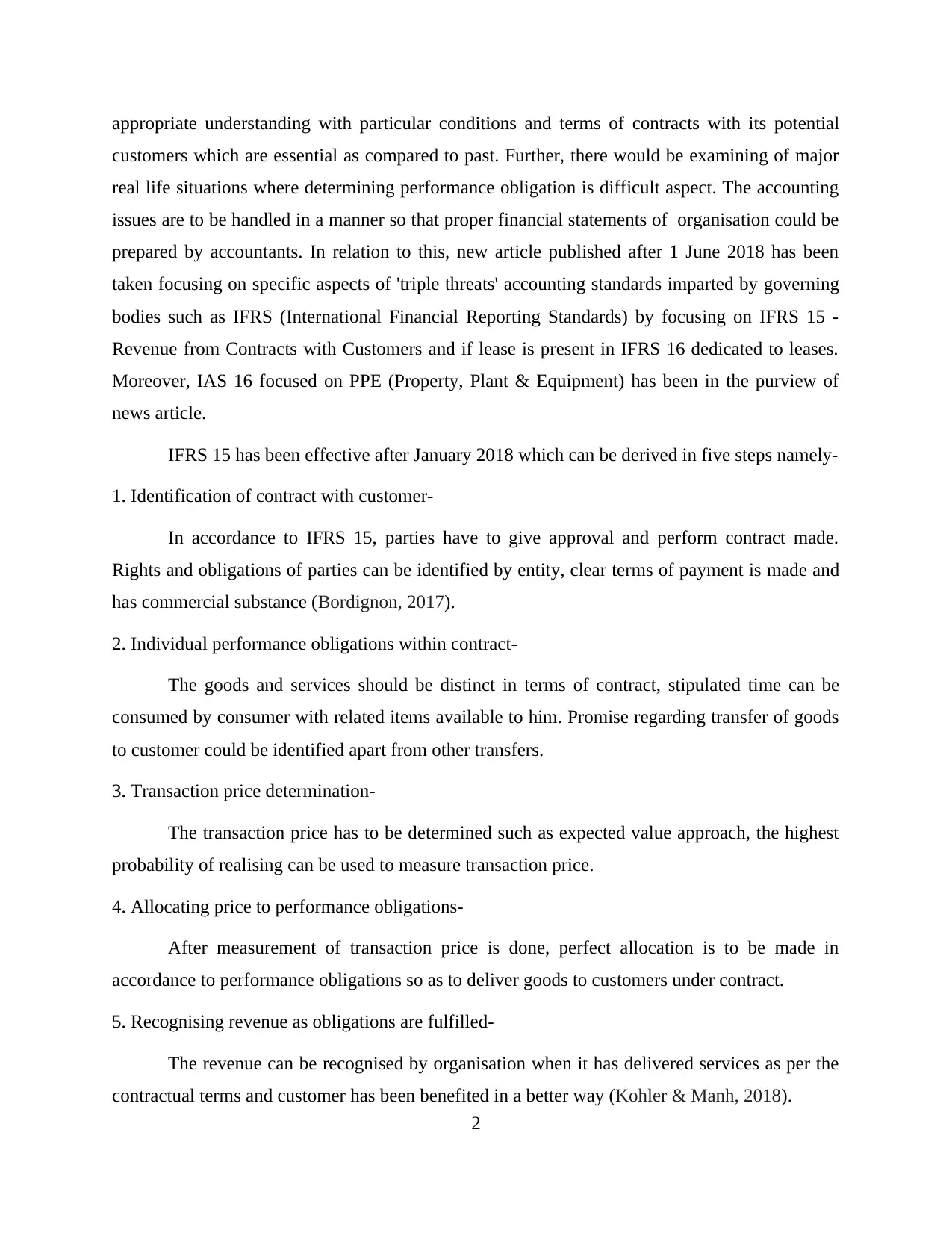
appropriate understanding with particular conditions and terms of contracts with its potential
customers which are essential as compared to past. Further, there would be examining of major
real life situations where determining performance obligation is difficult aspect. The accounting
issues are to be handled in a manner so that proper financial statements of organisation could be
prepared by accountants. In relation to this, new article published after 1 June 2018 has been
taken focusing on specific aspects of 'triple threats' accounting standards imparted by governing
bodies such as IFRS (International Financial Reporting Standards) by focusing on IFRS 15 -
Revenue from Contracts with Customers and if lease is present in IFRS 16 dedicated to leases.
Moreover, IAS 16 focused on PPE (Property, Plant & Equipment) has been in the purview of
news article.
IFRS 15 has been effective after January 2018 which can be derived in five steps namely-
1. Identification of contract with customer-
In accordance to IFRS 15, parties have to give approval and perform contract made.
Rights and obligations of parties can be identified by entity, clear terms of payment is made and
has commercial substance (Bordignon, 2017).
2. Individual performance obligations within contract-
The goods and services should be distinct in terms of contract, stipulated time can be
consumed by consumer with related items available to him. Promise regarding transfer of goods
to customer could be identified apart from other transfers.
3. Transaction price determination-
The transaction price has to be determined such as expected value approach, the highest
probability of realising can be used to measure transaction price.
4. Allocating price to performance obligations-
After measurement of transaction price is done, perfect allocation is to be made in
accordance to performance obligations so as to deliver goods to customers under contract.
5. Recognising revenue as obligations are fulfilled-
The revenue can be recognised by organisation when it has delivered services as per the
contractual terms and customer has been benefited in a better way (Kohler & Manh, 2018).
2
customers which are essential as compared to past. Further, there would be examining of major
real life situations where determining performance obligation is difficult aspect. The accounting
issues are to be handled in a manner so that proper financial statements of organisation could be
prepared by accountants. In relation to this, new article published after 1 June 2018 has been
taken focusing on specific aspects of 'triple threats' accounting standards imparted by governing
bodies such as IFRS (International Financial Reporting Standards) by focusing on IFRS 15 -
Revenue from Contracts with Customers and if lease is present in IFRS 16 dedicated to leases.
Moreover, IAS 16 focused on PPE (Property, Plant & Equipment) has been in the purview of
news article.
IFRS 15 has been effective after January 2018 which can be derived in five steps namely-
1. Identification of contract with customer-
In accordance to IFRS 15, parties have to give approval and perform contract made.
Rights and obligations of parties can be identified by entity, clear terms of payment is made and
has commercial substance (Bordignon, 2017).
2. Individual performance obligations within contract-
The goods and services should be distinct in terms of contract, stipulated time can be
consumed by consumer with related items available to him. Promise regarding transfer of goods
to customer could be identified apart from other transfers.
3. Transaction price determination-
The transaction price has to be determined such as expected value approach, the highest
probability of realising can be used to measure transaction price.
4. Allocating price to performance obligations-
After measurement of transaction price is done, perfect allocation is to be made in
accordance to performance obligations so as to deliver goods to customers under contract.
5. Recognising revenue as obligations are fulfilled-
The revenue can be recognised by organisation when it has delivered services as per the
contractual terms and customer has been benefited in a better way (Kohler & Manh, 2018).
2
Paraphrase This Document
Need a fresh take? Get an instant paraphrase of this document with our AI Paraphraser
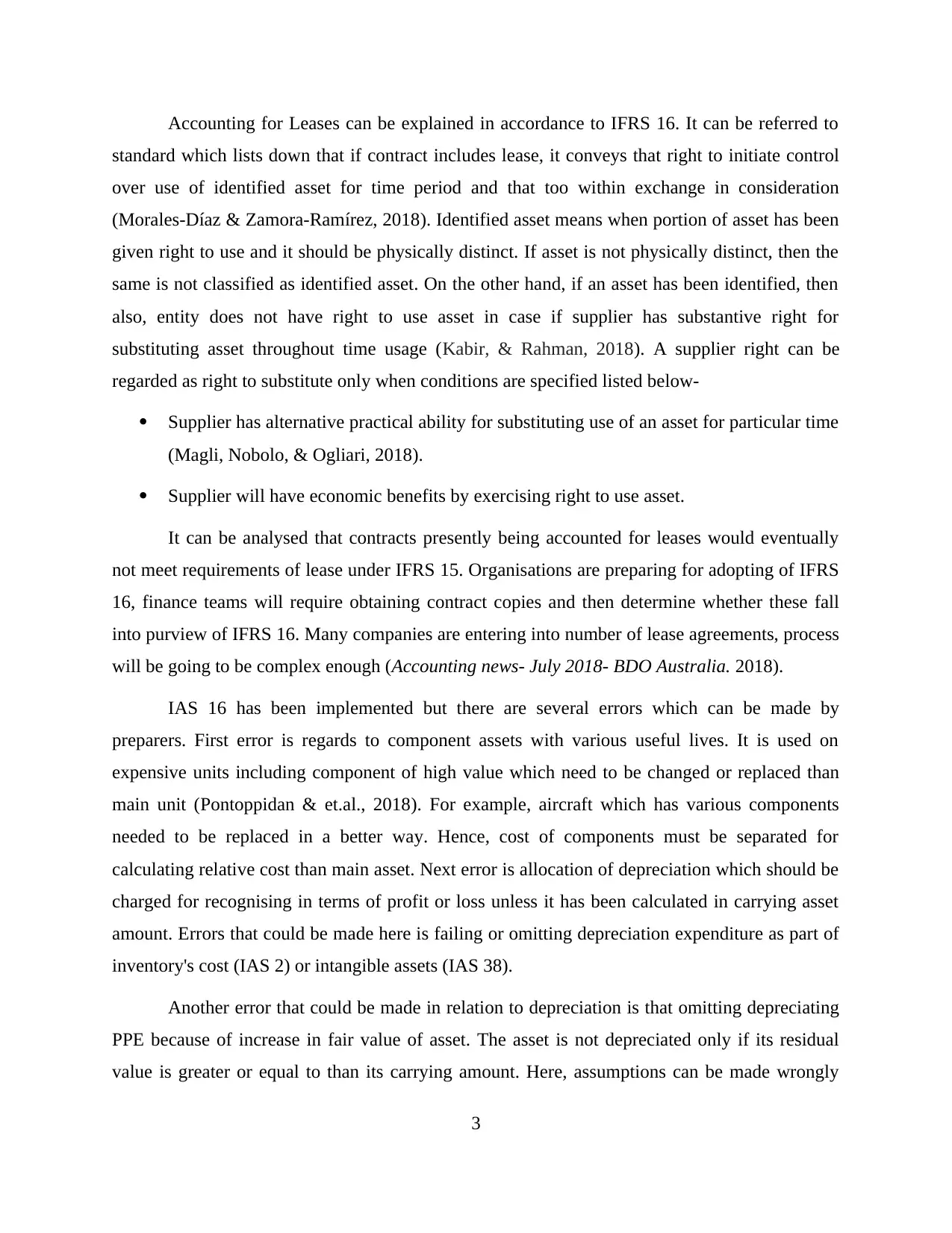
Accounting for Leases can be explained in accordance to IFRS 16. It can be referred to
standard which lists down that if contract includes lease, it conveys that right to initiate control
over use of identified asset for time period and that too within exchange in consideration
(Morales-Díaz & Zamora-Ramírez, 2018). Identified asset means when portion of asset has been
given right to use and it should be physically distinct. If asset is not physically distinct, then the
same is not classified as identified asset. On the other hand, if an asset has been identified, then
also, entity does not have right to use asset in case if supplier has substantive right for
substituting asset throughout time usage (Kabir, & Rahman, 2018). A supplier right can be
regarded as right to substitute only when conditions are specified listed below-
Supplier has alternative practical ability for substituting use of an asset for particular time
(Magli, Nobolo, & Ogliari, 2018).
Supplier will have economic benefits by exercising right to use asset.
It can be analysed that contracts presently being accounted for leases would eventually
not meet requirements of lease under IFRS 15. Organisations are preparing for adopting of IFRS
16, finance teams will require obtaining contract copies and then determine whether these fall
into purview of IFRS 16. Many companies are entering into number of lease agreements, process
will be going to be complex enough (Accounting news- July 2018- BDO Australia. 2018).
IAS 16 has been implemented but there are several errors which can be made by
preparers. First error is regards to component assets with various useful lives. It is used on
expensive units including component of high value which need to be changed or replaced than
main unit (Pontoppidan & et.al., 2018). For example, aircraft which has various components
needed to be replaced in a better way. Hence, cost of components must be separated for
calculating relative cost than main asset. Next error is allocation of depreciation which should be
charged for recognising in terms of profit or loss unless it has been calculated in carrying asset
amount. Errors that could be made here is failing or omitting depreciation expenditure as part of
inventory's cost (IAS 2) or intangible assets (IAS 38).
Another error that could be made in relation to depreciation is that omitting depreciating
PPE because of increase in fair value of asset. The asset is not depreciated only if its residual
value is greater or equal to than its carrying amount. Here, assumptions can be made wrongly
3
standard which lists down that if contract includes lease, it conveys that right to initiate control
over use of identified asset for time period and that too within exchange in consideration
(Morales-Díaz & Zamora-Ramírez, 2018). Identified asset means when portion of asset has been
given right to use and it should be physically distinct. If asset is not physically distinct, then the
same is not classified as identified asset. On the other hand, if an asset has been identified, then
also, entity does not have right to use asset in case if supplier has substantive right for
substituting asset throughout time usage (Kabir, & Rahman, 2018). A supplier right can be
regarded as right to substitute only when conditions are specified listed below-
Supplier has alternative practical ability for substituting use of an asset for particular time
(Magli, Nobolo, & Ogliari, 2018).
Supplier will have economic benefits by exercising right to use asset.
It can be analysed that contracts presently being accounted for leases would eventually
not meet requirements of lease under IFRS 15. Organisations are preparing for adopting of IFRS
16, finance teams will require obtaining contract copies and then determine whether these fall
into purview of IFRS 16. Many companies are entering into number of lease agreements, process
will be going to be complex enough (Accounting news- July 2018- BDO Australia. 2018).
IAS 16 has been implemented but there are several errors which can be made by
preparers. First error is regards to component assets with various useful lives. It is used on
expensive units including component of high value which need to be changed or replaced than
main unit (Pontoppidan & et.al., 2018). For example, aircraft which has various components
needed to be replaced in a better way. Hence, cost of components must be separated for
calculating relative cost than main asset. Next error is allocation of depreciation which should be
charged for recognising in terms of profit or loss unless it has been calculated in carrying asset
amount. Errors that could be made here is failing or omitting depreciation expenditure as part of
inventory's cost (IAS 2) or intangible assets (IAS 38).
Another error that could be made in relation to depreciation is that omitting depreciating
PPE because of increase in fair value of asset. The asset is not depreciated only if its residual
value is greater or equal to than its carrying amount. Here, assumptions can be made wrongly
3
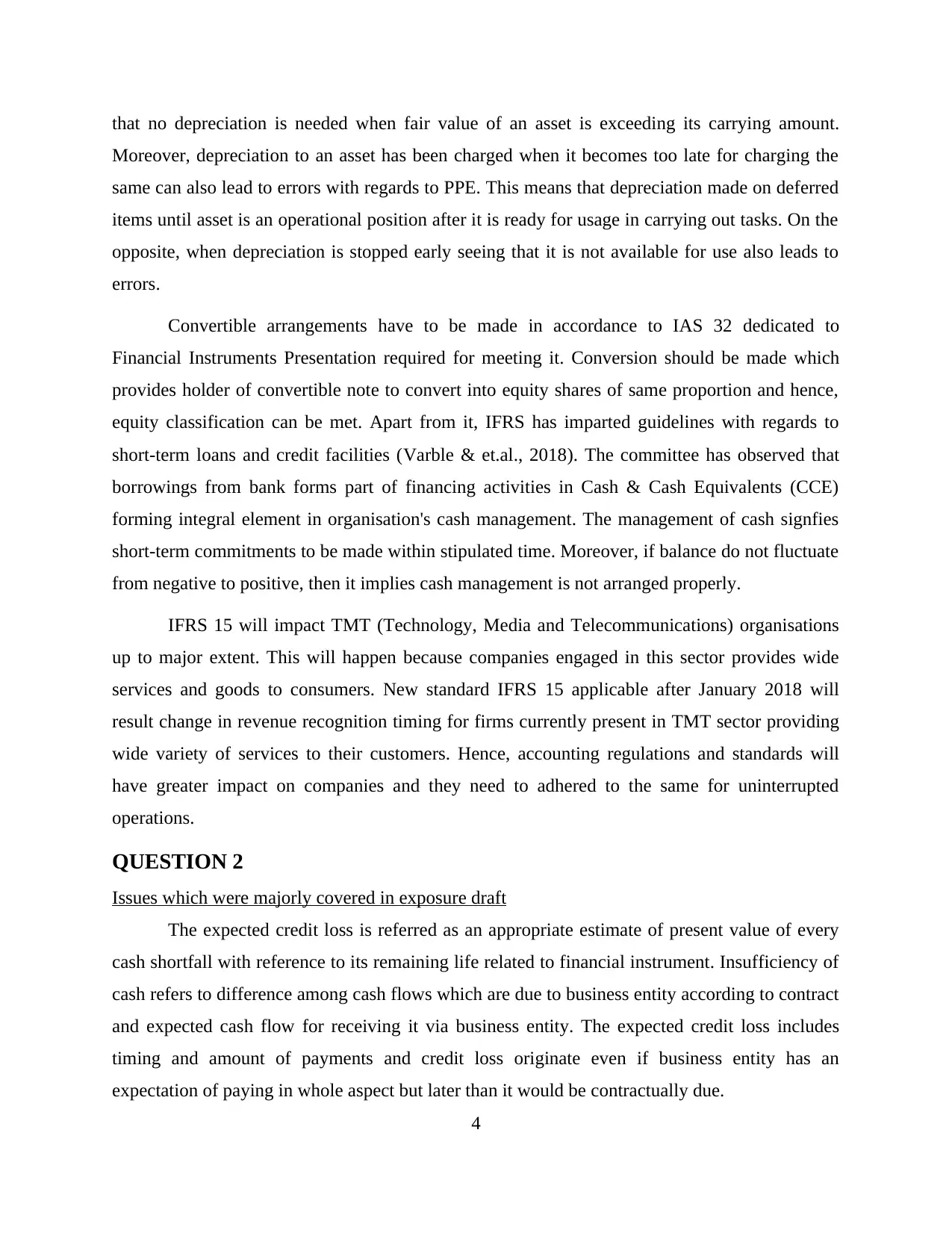
that no depreciation is needed when fair value of an asset is exceeding its carrying amount.
Moreover, depreciation to an asset has been charged when it becomes too late for charging the
same can also lead to errors with regards to PPE. This means that depreciation made on deferred
items until asset is an operational position after it is ready for usage in carrying out tasks. On the
opposite, when depreciation is stopped early seeing that it is not available for use also leads to
errors.
Convertible arrangements have to be made in accordance to IAS 32 dedicated to
Financial Instruments Presentation required for meeting it. Conversion should be made which
provides holder of convertible note to convert into equity shares of same proportion and hence,
equity classification can be met. Apart from it, IFRS has imparted guidelines with regards to
short-term loans and credit facilities (Varble & et.al., 2018). The committee has observed that
borrowings from bank forms part of financing activities in Cash & Cash Equivalents (CCE)
forming integral element in organisation's cash management. The management of cash signfies
short-term commitments to be made within stipulated time. Moreover, if balance do not fluctuate
from negative to positive, then it implies cash management is not arranged properly.
IFRS 15 will impact TMT (Technology, Media and Telecommunications) organisations
up to major extent. This will happen because companies engaged in this sector provides wide
services and goods to consumers. New standard IFRS 15 applicable after January 2018 will
result change in revenue recognition timing for firms currently present in TMT sector providing
wide variety of services to their customers. Hence, accounting regulations and standards will
have greater impact on companies and they need to adhered to the same for uninterrupted
operations.
QUESTION 2
Issues which were majorly covered in exposure draft
The expected credit loss is referred as an appropriate estimate of present value of every
cash shortfall with reference to its remaining life related to financial instrument. Insufficiency of
cash refers to difference among cash flows which are due to business entity according to contract
and expected cash flow for receiving it via business entity. The expected credit loss includes
timing and amount of payments and credit loss originate even if business entity has an
expectation of paying in whole aspect but later than it would be contractually due.
4
Moreover, depreciation to an asset has been charged when it becomes too late for charging the
same can also lead to errors with regards to PPE. This means that depreciation made on deferred
items until asset is an operational position after it is ready for usage in carrying out tasks. On the
opposite, when depreciation is stopped early seeing that it is not available for use also leads to
errors.
Convertible arrangements have to be made in accordance to IAS 32 dedicated to
Financial Instruments Presentation required for meeting it. Conversion should be made which
provides holder of convertible note to convert into equity shares of same proportion and hence,
equity classification can be met. Apart from it, IFRS has imparted guidelines with regards to
short-term loans and credit facilities (Varble & et.al., 2018). The committee has observed that
borrowings from bank forms part of financing activities in Cash & Cash Equivalents (CCE)
forming integral element in organisation's cash management. The management of cash signfies
short-term commitments to be made within stipulated time. Moreover, if balance do not fluctuate
from negative to positive, then it implies cash management is not arranged properly.
IFRS 15 will impact TMT (Technology, Media and Telecommunications) organisations
up to major extent. This will happen because companies engaged in this sector provides wide
services and goods to consumers. New standard IFRS 15 applicable after January 2018 will
result change in revenue recognition timing for firms currently present in TMT sector providing
wide variety of services to their customers. Hence, accounting regulations and standards will
have greater impact on companies and they need to adhered to the same for uninterrupted
operations.
QUESTION 2
Issues which were majorly covered in exposure draft
The expected credit loss is referred as an appropriate estimate of present value of every
cash shortfall with reference to its remaining life related to financial instrument. Insufficiency of
cash refers to difference among cash flows which are due to business entity according to contract
and expected cash flow for receiving it via business entity. The expected credit loss includes
timing and amount of payments and credit loss originate even if business entity has an
expectation of paying in whole aspect but later than it would be contractually due.
4
⊘ This is a preview!⊘
Do you want full access?
Subscribe today to unlock all pages.

Trusted by 1+ million students worldwide
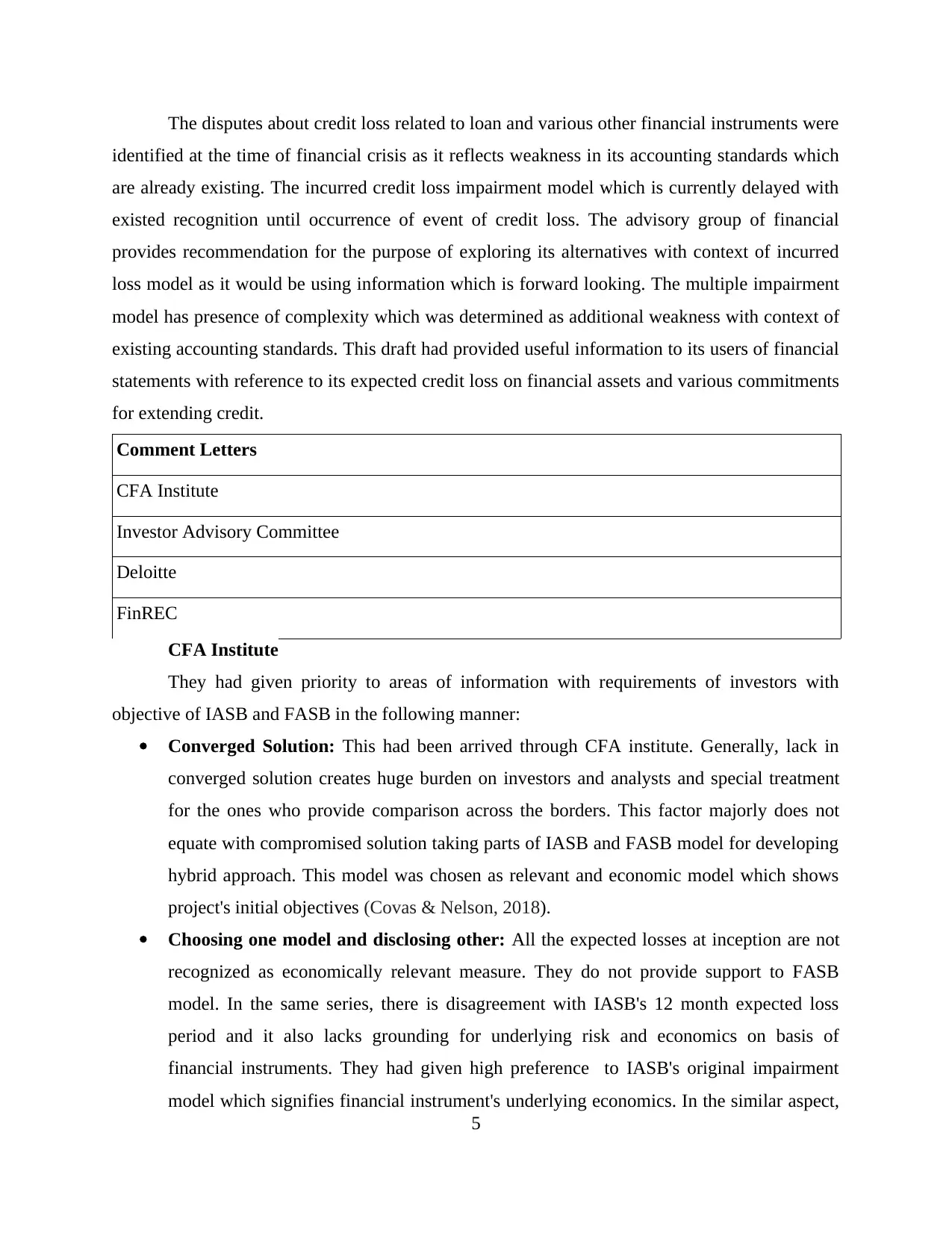
The disputes about credit loss related to loan and various other financial instruments were
identified at the time of financial crisis as it reflects weakness in its accounting standards which
are already existing. The incurred credit loss impairment model which is currently delayed with
existed recognition until occurrence of event of credit loss. The advisory group of financial
provides recommendation for the purpose of exploring its alternatives with context of incurred
loss model as it would be using information which is forward looking. The multiple impairment
model has presence of complexity which was determined as additional weakness with context of
existing accounting standards. This draft had provided useful information to its users of financial
statements with reference to its expected credit loss on financial assets and various commitments
for extending credit.
Comment Letters
CFA Institute
Investor Advisory Committee
Deloitte
FinREC
CFA Institute
They had given priority to areas of information with requirements of investors with
objective of IASB and FASB in the following manner:
Converged Solution: This had been arrived through CFA institute. Generally, lack in
converged solution creates huge burden on investors and analysts and special treatment
for the ones who provide comparison across the borders. This factor majorly does not
equate with compromised solution taking parts of IASB and FASB model for developing
hybrid approach. This model was chosen as relevant and economic model which shows
project's initial objectives (Covas & Nelson, 2018).
Choosing one model and disclosing other: All the expected losses at inception are not
recognized as economically relevant measure. They do not provide support to FASB
model. In the same series, there is disagreement with IASB's 12 month expected loss
period and it also lacks grounding for underlying risk and economics on basis of
financial instruments. They had given high preference to IASB's original impairment
model which signifies financial instrument's underlying economics. In the similar aspect,
5
identified at the time of financial crisis as it reflects weakness in its accounting standards which
are already existing. The incurred credit loss impairment model which is currently delayed with
existed recognition until occurrence of event of credit loss. The advisory group of financial
provides recommendation for the purpose of exploring its alternatives with context of incurred
loss model as it would be using information which is forward looking. The multiple impairment
model has presence of complexity which was determined as additional weakness with context of
existing accounting standards. This draft had provided useful information to its users of financial
statements with reference to its expected credit loss on financial assets and various commitments
for extending credit.
Comment Letters
CFA Institute
Investor Advisory Committee
Deloitte
FinREC
CFA Institute
They had given priority to areas of information with requirements of investors with
objective of IASB and FASB in the following manner:
Converged Solution: This had been arrived through CFA institute. Generally, lack in
converged solution creates huge burden on investors and analysts and special treatment
for the ones who provide comparison across the borders. This factor majorly does not
equate with compromised solution taking parts of IASB and FASB model for developing
hybrid approach. This model was chosen as relevant and economic model which shows
project's initial objectives (Covas & Nelson, 2018).
Choosing one model and disclosing other: All the expected losses at inception are not
recognized as economically relevant measure. They do not provide support to FASB
model. In the same series, there is disagreement with IASB's 12 month expected loss
period and it also lacks grounding for underlying risk and economics on basis of
financial instruments. They had given high preference to IASB's original impairment
model which signifies financial instrument's underlying economics. In the similar aspect,
5
Paraphrase This Document
Need a fresh take? Get an instant paraphrase of this document with our AI Paraphraser
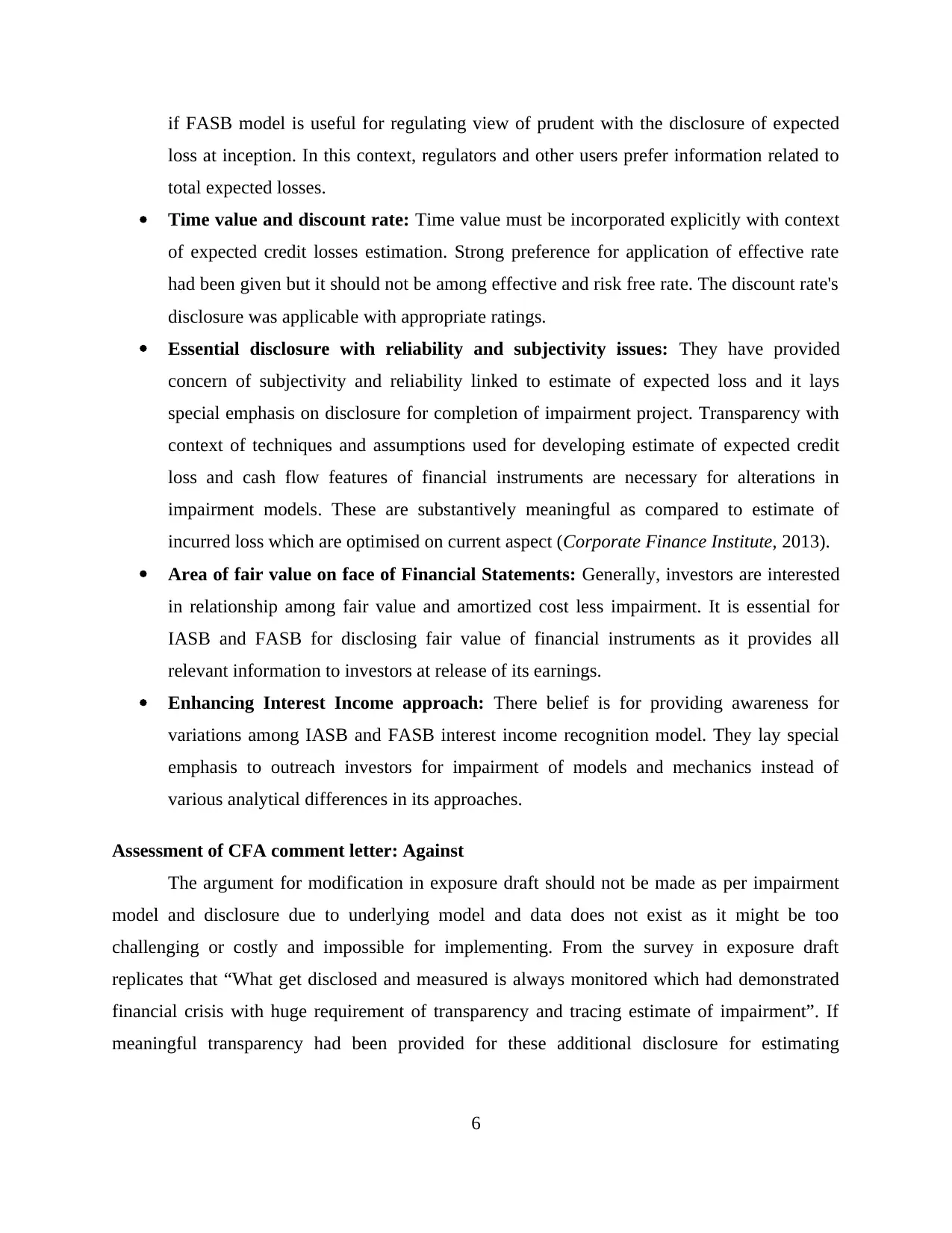
if FASB model is useful for regulating view of prudent with the disclosure of expected
loss at inception. In this context, regulators and other users prefer information related to
total expected losses.
Time value and discount rate: Time value must be incorporated explicitly with context
of expected credit losses estimation. Strong preference for application of effective rate
had been given but it should not be among effective and risk free rate. The discount rate's
disclosure was applicable with appropriate ratings.
Essential disclosure with reliability and subjectivity issues: They have provided
concern of subjectivity and reliability linked to estimate of expected loss and it lays
special emphasis on disclosure for completion of impairment project. Transparency with
context of techniques and assumptions used for developing estimate of expected credit
loss and cash flow features of financial instruments are necessary for alterations in
impairment models. These are substantively meaningful as compared to estimate of
incurred loss which are optimised on current aspect (Corporate Finance Institute, 2013).
Area of fair value on face of Financial Statements: Generally, investors are interested
in relationship among fair value and amortized cost less impairment. It is essential for
IASB and FASB for disclosing fair value of financial instruments as it provides all
relevant information to investors at release of its earnings.
Enhancing Interest Income approach: There belief is for providing awareness for
variations among IASB and FASB interest income recognition model. They lay special
emphasis to outreach investors for impairment of models and mechanics instead of
various analytical differences in its approaches.
Assessment of CFA comment letter: Against
The argument for modification in exposure draft should not be made as per impairment
model and disclosure due to underlying model and data does not exist as it might be too
challenging or costly and impossible for implementing. From the survey in exposure draft
replicates that “What get disclosed and measured is always monitored which had demonstrated
financial crisis with huge requirement of transparency and tracing estimate of impairment”. If
meaningful transparency had been provided for these additional disclosure for estimating
6
loss at inception. In this context, regulators and other users prefer information related to
total expected losses.
Time value and discount rate: Time value must be incorporated explicitly with context
of expected credit losses estimation. Strong preference for application of effective rate
had been given but it should not be among effective and risk free rate. The discount rate's
disclosure was applicable with appropriate ratings.
Essential disclosure with reliability and subjectivity issues: They have provided
concern of subjectivity and reliability linked to estimate of expected loss and it lays
special emphasis on disclosure for completion of impairment project. Transparency with
context of techniques and assumptions used for developing estimate of expected credit
loss and cash flow features of financial instruments are necessary for alterations in
impairment models. These are substantively meaningful as compared to estimate of
incurred loss which are optimised on current aspect (Corporate Finance Institute, 2013).
Area of fair value on face of Financial Statements: Generally, investors are interested
in relationship among fair value and amortized cost less impairment. It is essential for
IASB and FASB for disclosing fair value of financial instruments as it provides all
relevant information to investors at release of its earnings.
Enhancing Interest Income approach: There belief is for providing awareness for
variations among IASB and FASB interest income recognition model. They lay special
emphasis to outreach investors for impairment of models and mechanics instead of
various analytical differences in its approaches.
Assessment of CFA comment letter: Against
The argument for modification in exposure draft should not be made as per impairment
model and disclosure due to underlying model and data does not exist as it might be too
challenging or costly and impossible for implementing. From the survey in exposure draft
replicates that “What get disclosed and measured is always monitored which had demonstrated
financial crisis with huge requirement of transparency and tracing estimate of impairment”. If
meaningful transparency had been provided for these additional disclosure for estimating
6
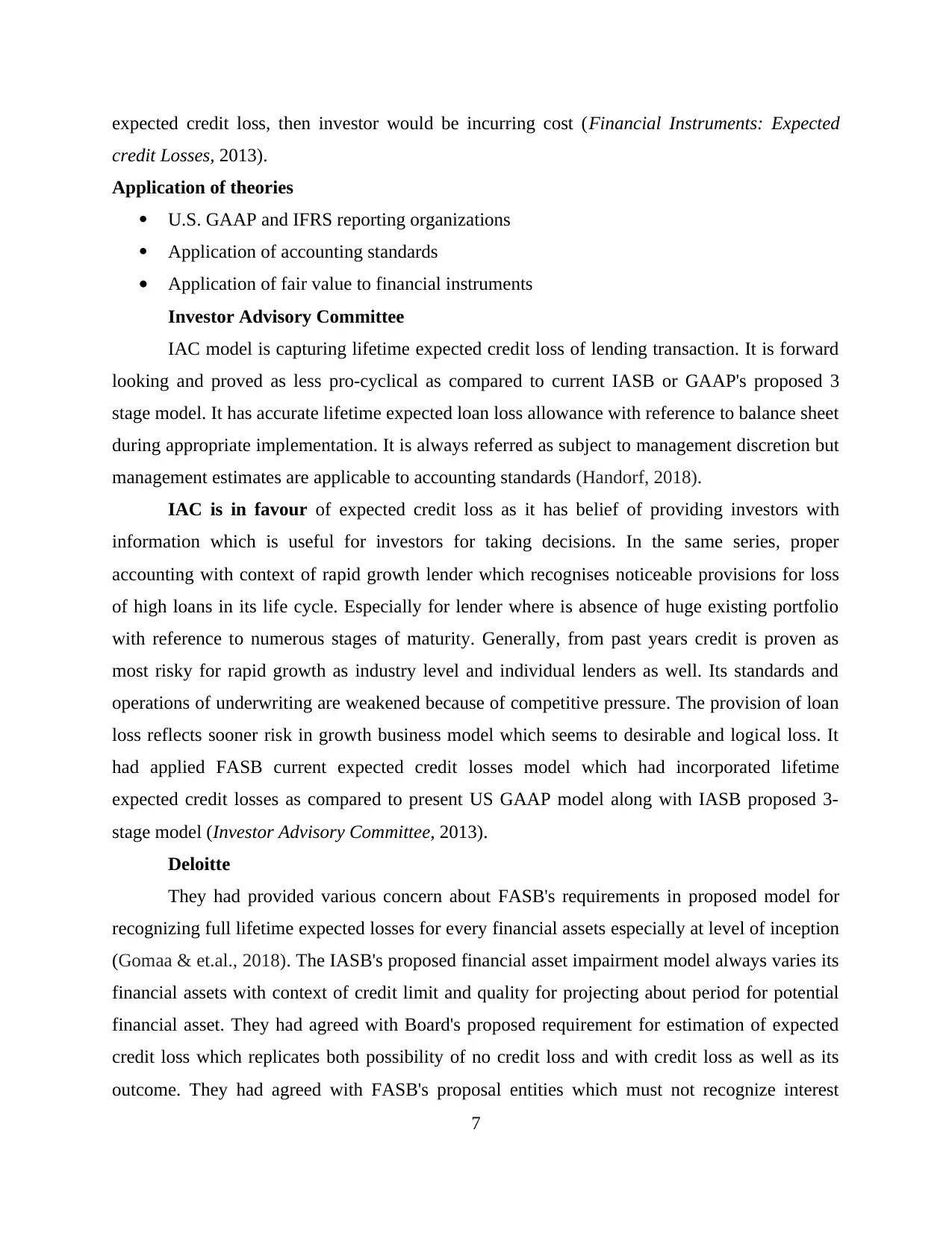
expected credit loss, then investor would be incurring cost (Financial Instruments: Expected
credit Losses, 2013).
Application of theories
U.S. GAAP and IFRS reporting organizations
Application of accounting standards
Application of fair value to financial instruments
Investor Advisory Committee
IAC model is capturing lifetime expected credit loss of lending transaction. It is forward
looking and proved as less pro-cyclical as compared to current IASB or GAAP's proposed 3
stage model. It has accurate lifetime expected loan loss allowance with reference to balance sheet
during appropriate implementation. It is always referred as subject to management discretion but
management estimates are applicable to accounting standards (Handorf, 2018).
IAC is in favour of expected credit loss as it has belief of providing investors with
information which is useful for investors for taking decisions. In the same series, proper
accounting with context of rapid growth lender which recognises noticeable provisions for loss
of high loans in its life cycle. Especially for lender where is absence of huge existing portfolio
with reference to numerous stages of maturity. Generally, from past years credit is proven as
most risky for rapid growth as industry level and individual lenders as well. Its standards and
operations of underwriting are weakened because of competitive pressure. The provision of loan
loss reflects sooner risk in growth business model which seems to desirable and logical loss. It
had applied FASB current expected credit losses model which had incorporated lifetime
expected credit losses as compared to present US GAAP model along with IASB proposed 3-
stage model (Investor Advisory Committee, 2013).
Deloitte
They had provided various concern about FASB's requirements in proposed model for
recognizing full lifetime expected losses for every financial assets especially at level of inception
(Gomaa & et.al., 2018). The IASB's proposed financial asset impairment model always varies its
financial assets with context of credit limit and quality for projecting about period for potential
financial asset. They had agreed with Board's proposed requirement for estimation of expected
credit loss which replicates both possibility of no credit loss and with credit loss as well as its
outcome. They had agreed with FASB's proposal entities which must not recognize interest
7
credit Losses, 2013).
Application of theories
U.S. GAAP and IFRS reporting organizations
Application of accounting standards
Application of fair value to financial instruments
Investor Advisory Committee
IAC model is capturing lifetime expected credit loss of lending transaction. It is forward
looking and proved as less pro-cyclical as compared to current IASB or GAAP's proposed 3
stage model. It has accurate lifetime expected loan loss allowance with reference to balance sheet
during appropriate implementation. It is always referred as subject to management discretion but
management estimates are applicable to accounting standards (Handorf, 2018).
IAC is in favour of expected credit loss as it has belief of providing investors with
information which is useful for investors for taking decisions. In the same series, proper
accounting with context of rapid growth lender which recognises noticeable provisions for loss
of high loans in its life cycle. Especially for lender where is absence of huge existing portfolio
with reference to numerous stages of maturity. Generally, from past years credit is proven as
most risky for rapid growth as industry level and individual lenders as well. Its standards and
operations of underwriting are weakened because of competitive pressure. The provision of loan
loss reflects sooner risk in growth business model which seems to desirable and logical loss. It
had applied FASB current expected credit losses model which had incorporated lifetime
expected credit losses as compared to present US GAAP model along with IASB proposed 3-
stage model (Investor Advisory Committee, 2013).
Deloitte
They had provided various concern about FASB's requirements in proposed model for
recognizing full lifetime expected losses for every financial assets especially at level of inception
(Gomaa & et.al., 2018). The IASB's proposed financial asset impairment model always varies its
financial assets with context of credit limit and quality for projecting about period for potential
financial asset. They had agreed with Board's proposed requirement for estimation of expected
credit loss which replicates both possibility of no credit loss and with credit loss as well as its
outcome. They had agreed with FASB's proposal entities which must not recognize interest
7
⊘ This is a preview!⊘
Do you want full access?
Subscribe today to unlock all pages.

Trusted by 1+ million students worldwide
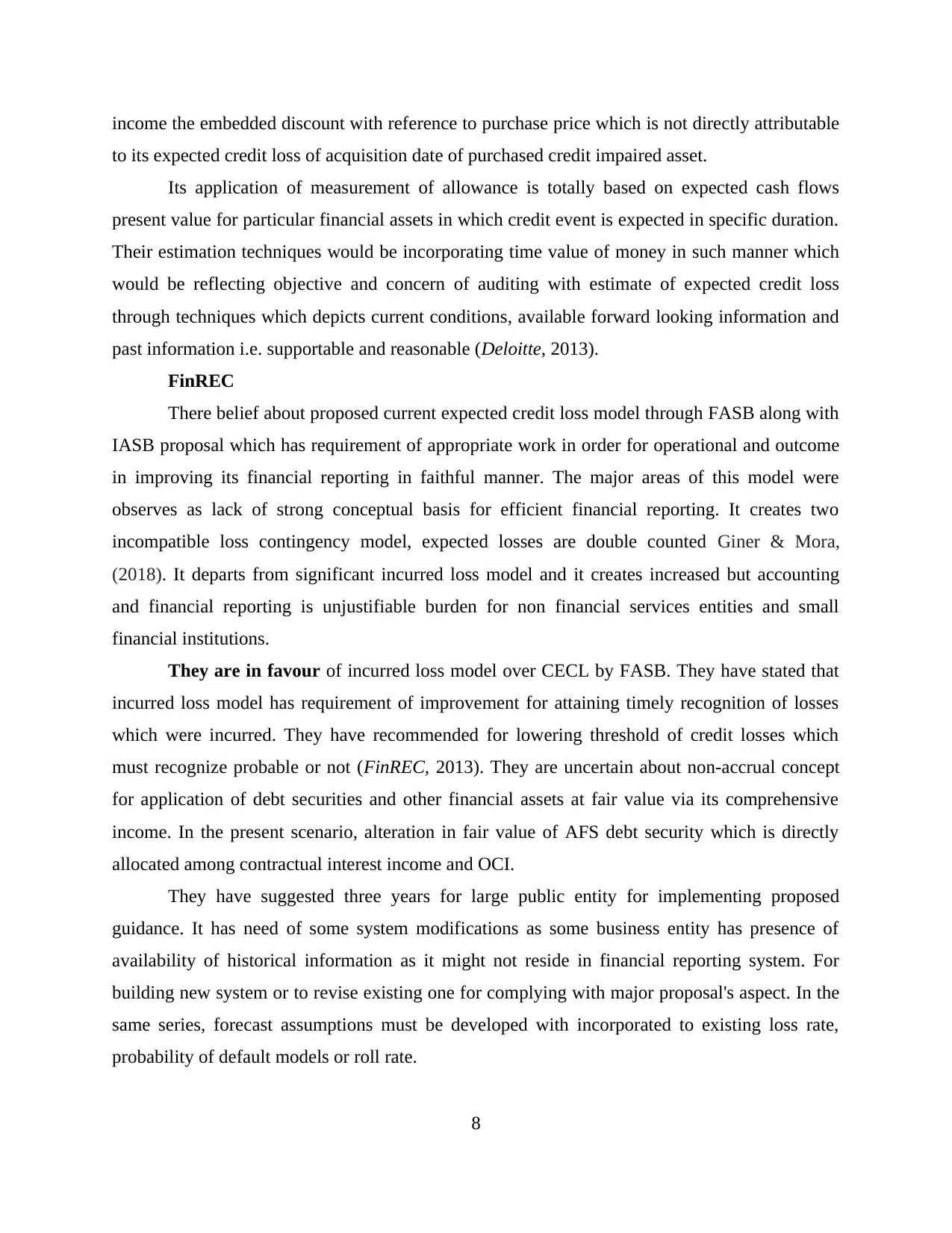
income the embedded discount with reference to purchase price which is not directly attributable
to its expected credit loss of acquisition date of purchased credit impaired asset.
Its application of measurement of allowance is totally based on expected cash flows
present value for particular financial assets in which credit event is expected in specific duration.
Their estimation techniques would be incorporating time value of money in such manner which
would be reflecting objective and concern of auditing with estimate of expected credit loss
through techniques which depicts current conditions, available forward looking information and
past information i.e. supportable and reasonable (Deloitte, 2013).
FinREC
There belief about proposed current expected credit loss model through FASB along with
IASB proposal which has requirement of appropriate work in order for operational and outcome
in improving its financial reporting in faithful manner. The major areas of this model were
observes as lack of strong conceptual basis for efficient financial reporting. It creates two
incompatible loss contingency model, expected losses are double counted Giner & Mora,
(2018). It departs from significant incurred loss model and it creates increased but accounting
and financial reporting is unjustifiable burden for non financial services entities and small
financial institutions.
They are in favour of incurred loss model over CECL by FASB. They have stated that
incurred loss model has requirement of improvement for attaining timely recognition of losses
which were incurred. They have recommended for lowering threshold of credit losses which
must recognize probable or not (FinREC, 2013). They are uncertain about non-accrual concept
for application of debt securities and other financial assets at fair value via its comprehensive
income. In the present scenario, alteration in fair value of AFS debt security which is directly
allocated among contractual interest income and OCI.
They have suggested three years for large public entity for implementing proposed
guidance. It has need of some system modifications as some business entity has presence of
availability of historical information as it might not reside in financial reporting system. For
building new system or to revise existing one for complying with major proposal's aspect. In the
same series, forecast assumptions must be developed with incorporated to existing loss rate,
probability of default models or roll rate.
8
to its expected credit loss of acquisition date of purchased credit impaired asset.
Its application of measurement of allowance is totally based on expected cash flows
present value for particular financial assets in which credit event is expected in specific duration.
Their estimation techniques would be incorporating time value of money in such manner which
would be reflecting objective and concern of auditing with estimate of expected credit loss
through techniques which depicts current conditions, available forward looking information and
past information i.e. supportable and reasonable (Deloitte, 2013).
FinREC
There belief about proposed current expected credit loss model through FASB along with
IASB proposal which has requirement of appropriate work in order for operational and outcome
in improving its financial reporting in faithful manner. The major areas of this model were
observes as lack of strong conceptual basis for efficient financial reporting. It creates two
incompatible loss contingency model, expected losses are double counted Giner & Mora,
(2018). It departs from significant incurred loss model and it creates increased but accounting
and financial reporting is unjustifiable burden for non financial services entities and small
financial institutions.
They are in favour of incurred loss model over CECL by FASB. They have stated that
incurred loss model has requirement of improvement for attaining timely recognition of losses
which were incurred. They have recommended for lowering threshold of credit losses which
must recognize probable or not (FinREC, 2013). They are uncertain about non-accrual concept
for application of debt securities and other financial assets at fair value via its comprehensive
income. In the present scenario, alteration in fair value of AFS debt security which is directly
allocated among contractual interest income and OCI.
They have suggested three years for large public entity for implementing proposed
guidance. It has need of some system modifications as some business entity has presence of
availability of historical information as it might not reside in financial reporting system. For
building new system or to revise existing one for complying with major proposal's aspect. In the
same series, forecast assumptions must be developed with incorporated to existing loss rate,
probability of default models or roll rate.
8
Paraphrase This Document
Need a fresh take? Get an instant paraphrase of this document with our AI Paraphraser
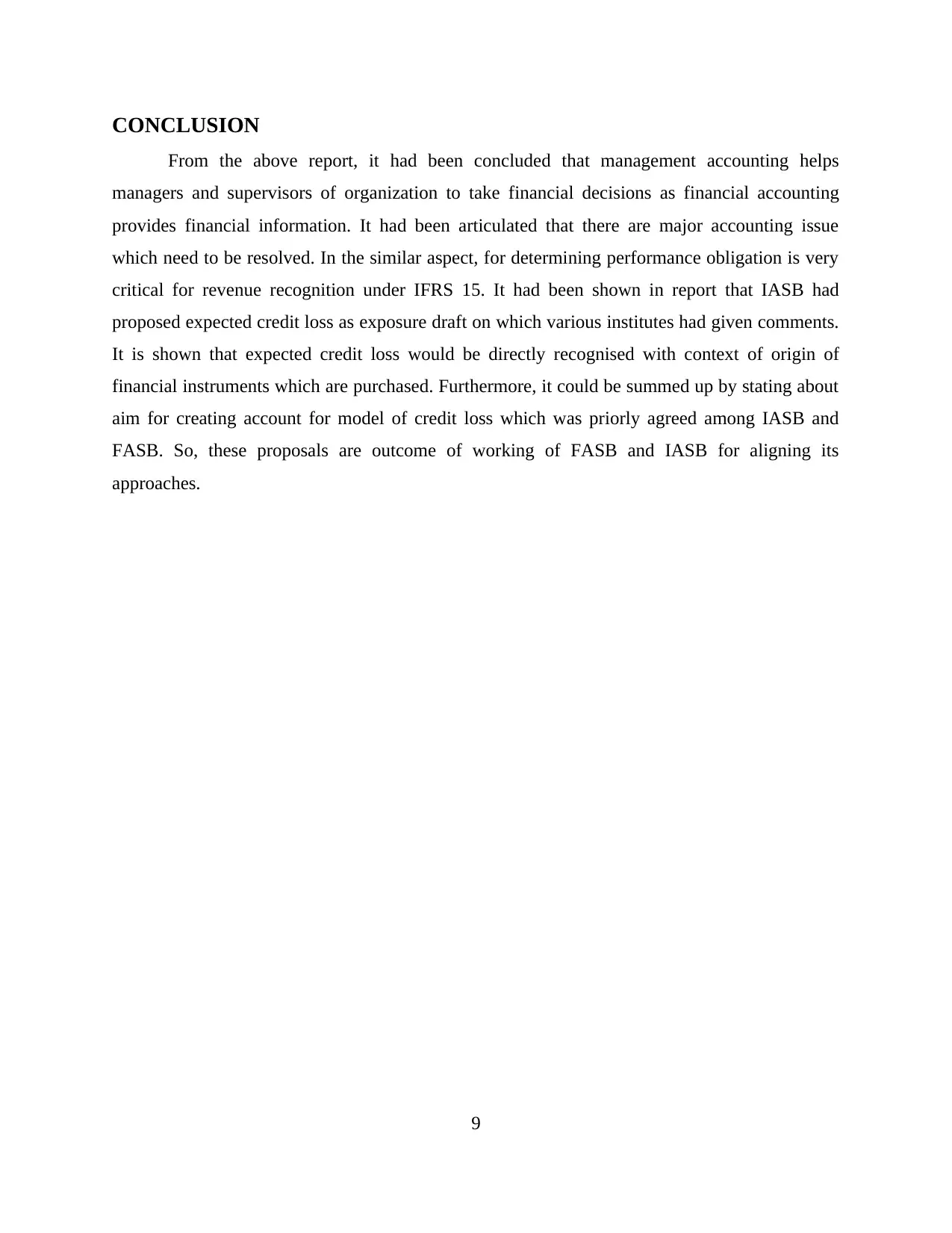
CONCLUSION
From the above report, it had been concluded that management accounting helps
managers and supervisors of organization to take financial decisions as financial accounting
provides financial information. It had been articulated that there are major accounting issue
which need to be resolved. In the similar aspect, for determining performance obligation is very
critical for revenue recognition under IFRS 15. It had been shown in report that IASB had
proposed expected credit loss as exposure draft on which various institutes had given comments.
It is shown that expected credit loss would be directly recognised with context of origin of
financial instruments which are purchased. Furthermore, it could be summed up by stating about
aim for creating account for model of credit loss which was priorly agreed among IASB and
FASB. So, these proposals are outcome of working of FASB and IASB for aligning its
approaches.
9
From the above report, it had been concluded that management accounting helps
managers and supervisors of organization to take financial decisions as financial accounting
provides financial information. It had been articulated that there are major accounting issue
which need to be resolved. In the similar aspect, for determining performance obligation is very
critical for revenue recognition under IFRS 15. It had been shown in report that IASB had
proposed expected credit loss as exposure draft on which various institutes had given comments.
It is shown that expected credit loss would be directly recognised with context of origin of
financial instruments which are purchased. Furthermore, it could be summed up by stating about
aim for creating account for model of credit loss which was priorly agreed among IASB and
FASB. So, these proposals are outcome of working of FASB and IASB for aligning its
approaches.
9
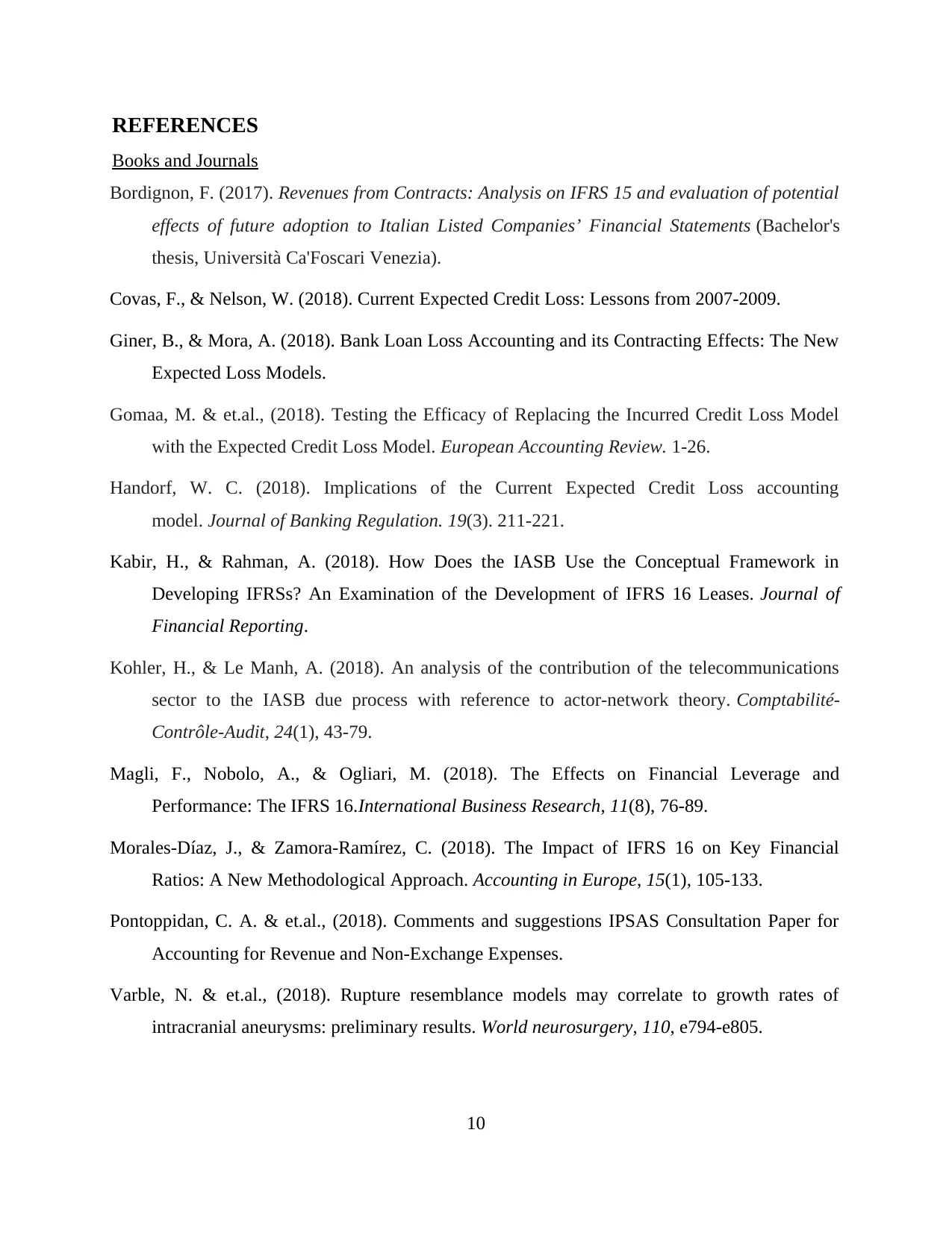
REFERENCES
Books and Journals
Bordignon, F. (2017). Revenues from Contracts: Analysis on IFRS 15 and evaluation of potential
effects of future adoption to Italian Listed Companies’ Financial Statements (Bachelor's
thesis, Università Ca'Foscari Venezia).
Covas, F., & Nelson, W. (2018). Current Expected Credit Loss: Lessons from 2007-2009.
Giner, B., & Mora, A. (2018). Bank Loan Loss Accounting and its Contracting Effects: The New
Expected Loss Models.
Gomaa, M. & et.al., (2018). Testing the Efficacy of Replacing the Incurred Credit Loss Model
with the Expected Credit Loss Model. European Accounting Review. 1-26.
Handorf, W. C. (2018). Implications of the Current Expected Credit Loss accounting
model. Journal of Banking Regulation. 19(3). 211-221.
Kabir, H., & Rahman, A. (2018). How Does the IASB Use the Conceptual Framework in
Developing IFRSs? An Examination of the Development of IFRS 16 Leases. Journal of
Financial Reporting.
Kohler, H., & Le Manh, A. (2018). An analysis of the contribution of the telecommunications
sector to the IASB due process with reference to actor-network theory. Comptabilité-
Contrôle-Audit, 24(1), 43-79.
Magli, F., Nobolo, A., & Ogliari, M. (2018). The Effects on Financial Leverage and
Performance: The IFRS 16.International Business Research, 11(8), 76-89.
Morales-Díaz, J., & Zamora-Ramírez, C. (2018). The Impact of IFRS 16 on Key Financial
Ratios: A New Methodological Approach. Accounting in Europe, 15(1), 105-133.
Pontoppidan, C. A. & et.al., (2018). Comments and suggestions IPSAS Consultation Paper for
Accounting for Revenue and Non-Exchange Expenses.
Varble, N. & et.al., (2018). Rupture resemblance models may correlate to growth rates of
intracranial aneurysms: preliminary results. World neurosurgery, 110, e794-e805.
10
Books and Journals
Bordignon, F. (2017). Revenues from Contracts: Analysis on IFRS 15 and evaluation of potential
effects of future adoption to Italian Listed Companies’ Financial Statements (Bachelor's
thesis, Università Ca'Foscari Venezia).
Covas, F., & Nelson, W. (2018). Current Expected Credit Loss: Lessons from 2007-2009.
Giner, B., & Mora, A. (2018). Bank Loan Loss Accounting and its Contracting Effects: The New
Expected Loss Models.
Gomaa, M. & et.al., (2018). Testing the Efficacy of Replacing the Incurred Credit Loss Model
with the Expected Credit Loss Model. European Accounting Review. 1-26.
Handorf, W. C. (2018). Implications of the Current Expected Credit Loss accounting
model. Journal of Banking Regulation. 19(3). 211-221.
Kabir, H., & Rahman, A. (2018). How Does the IASB Use the Conceptual Framework in
Developing IFRSs? An Examination of the Development of IFRS 16 Leases. Journal of
Financial Reporting.
Kohler, H., & Le Manh, A. (2018). An analysis of the contribution of the telecommunications
sector to the IASB due process with reference to actor-network theory. Comptabilité-
Contrôle-Audit, 24(1), 43-79.
Magli, F., Nobolo, A., & Ogliari, M. (2018). The Effects on Financial Leverage and
Performance: The IFRS 16.International Business Research, 11(8), 76-89.
Morales-Díaz, J., & Zamora-Ramírez, C. (2018). The Impact of IFRS 16 on Key Financial
Ratios: A New Methodological Approach. Accounting in Europe, 15(1), 105-133.
Pontoppidan, C. A. & et.al., (2018). Comments and suggestions IPSAS Consultation Paper for
Accounting for Revenue and Non-Exchange Expenses.
Varble, N. & et.al., (2018). Rupture resemblance models may correlate to growth rates of
intracranial aneurysms: preliminary results. World neurosurgery, 110, e794-e805.
10
⊘ This is a preview!⊘
Do you want full access?
Subscribe today to unlock all pages.

Trusted by 1+ million students worldwide
1 out of 13
Related Documents
Your All-in-One AI-Powered Toolkit for Academic Success.
+13062052269
info@desklib.com
Available 24*7 on WhatsApp / Email
![[object Object]](/_next/static/media/star-bottom.7253800d.svg)
Unlock your academic potential
Copyright © 2020–2025 A2Z Services. All Rights Reserved. Developed and managed by ZUCOL.





